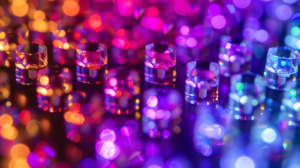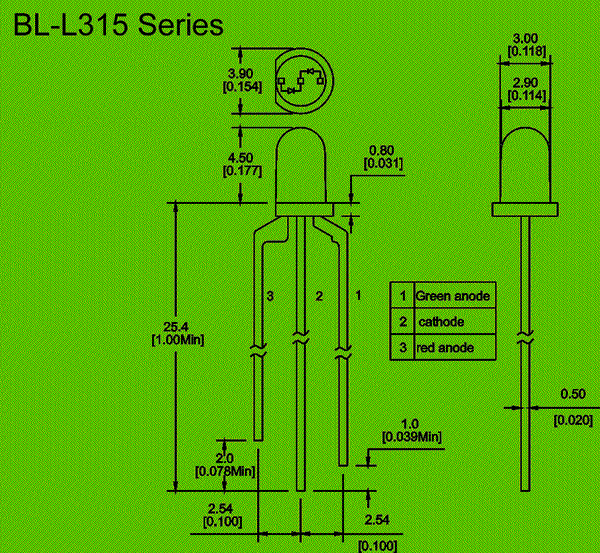3mm Bi-color LED diode | 3 pin | Ultra Green
Article No:
Color:
Weight:(g/pcs)
Dimension:(mm)
Inquiry
Related Article List
Article No | color | material | wavelength | apperance | v_typ | v_max | luminous_min | luminous_typ | degree |
|---|---|---|---|---|---|---|---|---|---|
Green |
GaP/GaP |
570 |
Water Diff. |
2.5 |
3 |
10 |
60 |
||
Orange |
GaAsP/GaP |
635 |
Water Diff. |
2.5 |
5 |
15 |
60 |
||
Ultra Yellow |
AlGaInP |
630 |
Water Diff. |
2.5 |
90 |
180 |
60 |
||
Ultra Green |
AlGaInP |
574 |
Water Diff. |
2.5 |
70 |
120 |
60 |
||
Green |
GaP/GaP |
570 |
Water Diff. |
2.5 |
3 |
10 |
60 |
||
Yellow |
GaAsP/GaP |
585 |
Water Diff. |
2.5 |
3 |
10 |
60 |
Product Series information
Product Series |
|---|
 Series No:BL-L315 Dimension 3 × 3.9 × 5.3 mm Description: ___________________________________________________________________________________________________________________________________________________ Introduction to 3mm Bi-color LED DiodesBicolor LEDs, particularly the 3mm variety with a 3-pin setup, represent a significant leap in LED technology. Designed to offer two distinct colors from a single package, these LEDs provide designers with the flexibility to signal different statuses or create colorful displays in limited spaces. Their integration into electronic components and led circuit boards exemplifies the innovation driving today's electronics industry.Features of 3mm Bi-color LED DiodesThe hallmark of the 3mm bi-color LED is its compact size coupled with dual-color functionality. This unique capability is achieved through a 3-pin configuration, where each color is controlled independently, allowing for a seamless transition or combination of colors. Such versatility makes these LEDs invaluable in design, where space and functionality are paramount.Applications Across IndustriesFrom consumer electronics to automotive dashboards, the applications of 3mm bi-color LED diodes are vast. They serve as power indicators, status alerts, and are instrumental in creating user-friendly interfaces in devices. Additionally, their use extends to signal processing equipment and health-monitoring devices, where color differentiation enhances usability and safety.Advantages of Utilizing 3mm Bi-color LED DiodesThe integration of bi-color LEDs into electronic designs offers several advantages. Their dual-color output from a single component reduces the complexity and size of circuit boards. Moreover, their low power consumption and long lifespan contribute to energy-efficient and sustainable electronic designs, aligning with the industry's move towards greener solutions.Case Studies: Illuminating InnovationDelving into case studies provides a tangible perspective on the transformative impact of 3mm bi-color LED diodes. In one instance, a consumer electronics manufacturer integrated these LEDs into wearable devices, significantly enhancing the user interface with intuitive color-coded notifications. Another case highlights their application in industrial control panels, where they improved operational efficiency and safety through clear status indications.User Testimonials: In Their Own WordsUser testimonials underscore the practical benefits and reliability of 3mm bi-color LED diodes. Engineers commend their versatility and ease of integration, which have facilitated innovative designs and functionalities. Purchasers and administrators, on the other hand, appreciate the cost-effectiveness and durability of these components, noting their contribution to the overall value of electronic products.Conclusion: The Bright Future of 3mm Bi-color LED DiodesThe exploration into 3mm bi-color LED diodes reveals their indispensable role in modern electronics. By offering dual-color functionality in a compact package, they not only enhance the aesthetic and functional aspects of electronic devices but also contribute to more efficient and intuitive designs. As the electronics industry continues to evolve, the versatility and innovation of bi-color LEDs promise to light the way forward. Call to Action: Embrace the potential of 3mm bi-color LED diodes in your next electronic project. Discover the difference these compact, versatile components can make in enhancing functionality and design aesthetics. Let's innovate together. Features
Applications
___________________________________________________________________________________________________________________________________________________ Dimension and Circuit Drawing:  |
Related Information
Soldering
When soldering, leave a minimum of 2mm clearance from the base of the base of the lens to the soldering point. Dipping the lens into the solder must be avoided.
Do not apply any external stress to the lead frame during soldering while the LED is at high temperature.
Recommended soldering conditions:
| IR Reflow Soldering (for SMD display) | Wave Soldering | Soldering Iron | |||
| Pre-Heat | 150-180°C | Pre-Heat | 100°C Max. | Temperature | 300°C Max. |
| Pre-Heat Time | 120sec Max. | Pre-Heat Time | 60sec Max. | ||
| Peak Temperature | 260°C Max. | SolderWave | 260°C Max. | Soldering Time | 3sec Max.(one time only) |
| Soldering Time | 10 sec Max. | Soldering Time | 5sec Max. | ||
Note: Excessive soldering temperature and/or time might result in deformation of the LED lens or failure of the LED
ESD(Electrostatic Discharge)
Static Electricity or power surge will damage the LED.
Suggestions to prevent ESD (Electrostatic Discharge):
n Use a conductive wrist band or anti-electrostatic glove when handling these LEDs
n All devices, equipment, and machinery must be properly grounded
n Work tables, storage racks, etc. should be properly grounded
n Use ion blower to neutralize the static charge which might have built up on surface of the LED’s
plastic lens as a result of friction between LEDs during storage and handling
ESD-damaged LEDs will exhibit abnormal characteristics such as high reverse leakage current,
low forward voltage, or “no light on” at low currents. To verify for ESD damage, check for “light on”
and Vf of the suspect LEDs at low currents.
The Vf of “good” LEDs should be>2.0V@0.1mA for InGaN product and >1.4V@0.1mA for AlInGaP
product.

When selecting power for LED systems, it’s essential to understand several key parameters to ensure safe operation, longevity, and optimal performance. Here are some steps and considerations for LED power selection:
- Determine the Forward Voltage (Vf) of the LED(s):
Each LED has a forward voltage, which is the voltage at which the LED operates when the current is flowing through it. This value can typically be found in the LED’s datasheet.
- Determine the Forward Current (If) of the LED(s):
The forward current is the current at which the LED is designed to operate. Running an LED at higher than its rated current can reduce its lifespan and increase the heat it produces.
- Decide on the Configuration:
Series Configuration: When LEDs are connected in series, the forward voltages add up, but the current remains the same.
Parallel Configuration: When LEDs are connected in parallel, the forward voltage remains the same, but the currents add up. This configuration can be risky because if one LED fails or has a slightly lower forward voltage, it can cause the other LEDs to draw more current.
Calculate Total Power Requirements:
Power (W) = Total Forward Voltage (V) x Total Forward Current (A)
For example, if you have three LEDs connected in series, each with a forward voltage of 3V and a forward current of 20mA, the total power requirement would be:
Power = (3V + 3V + 3V) x 20mA = 9V x 0.02A = 0.18W
- Select an Appropriate Power Supply:
- Voltage Rating: The power supply voltage should match or slightly exceed the total forward voltage of your LED configuration.
- Current Rating: The power supply’s current rating should meet or exceed the total forward current of your LED configuration.
- Safety Margin: It’s a good practice to select a power supply that can provide at least 20% more power than your calculated requirement. This ensures the power supply isn’t operating at its maximum capacity, which can extend its life and ensure safer operation.
- Consider Additional Features:
- Dimming Capability: If you want to control the brightness of your LEDs, choose a power supply with dimming capabilities.
- Overcurrent and Overvoltage Protection: To protect your LEDs, select a power supply with built-in protection mechanisms.
- Thermal Management: Ensure that the power supply has adequate cooling, especially if it will be enclosed or in a location with limited airflow.
- Regulation and Efficiency:A power supply with good regulation will maintain a consistent voltage output despite variations in the load. High efficiency ensures minimal power is wasted as heat.
- Physical Size and Form Factor:Depending on where you plan to place the power supply, its size and shape may be critical factors.
In summary, when selecting power for LED systems, understanding your LED’s requirements and the configuration you plan to use is essential. Then, pick a power supply that meets those needs with some added safety margin, keeping in mind any additional features or constraints relevant to your project.
Here are some well-regarded brands in the industry:
- Mean Well: One of the most recognized brands in the LED power supply industry, Mean Well offers a wide range of products suitable for both indoor and outdoor applications. Their units often come with features like overcurrent protection, dimming capabilities, and high efficiency.
- Tridonic: A global leader in lighting technology, Tridonic offers LED drivers and power supplies that cater to various lighting solutions, from simple setups to advanced smart lighting systems.
- Philips Advance Xitanium: Philips is a well-known brand in the lighting industry, and their Xitanium series of LED drivers are known for reliability and performance. They cater to both indoor and outdoor LED applications.
- Osram: Another giant in the lighting industry, Osram offers a range of LED drivers and power supplies suitable for various applications, including architectural and street lighting.
- LIFUD: Specializing in LED drivers, LIFUD is known for its high-quality products that cater to both commercial and residential LED lighting solutions.
- MOSO: This brand offers a variety of LED drivers, especially for outdoor and industrial applications. Their products are known for durability and performance.
- TDK-Lambda: With a history in power electronics, TDK-Lambda offers a range of power supplies and LED drivers suitable for various applications, emphasizing reliability and advanced features.


